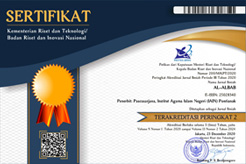Being Chinese Christian in the Totok Chinese Churches in Surabaya: Continuity and Change of Identities
Abstract
Keywords
Full Text:
PDFReferences
Arifin, E. N., Hasbullah, M. S., & Pramono, A. (2017). Chinese Indonesians: how many, who and where? Asian Ethnicity, 18(3), 310–329.
Basundoro, P. (2009). Dua kota tiga zaman: Surabaya dan Malang sejak kolonial sampai kemerdekaan. Malang: Penerbit Ombak.
Bhabha, H. K. (1994). The Location of Culture (Routledge Classics). New York: Routledge.
Chong, T. (2019). Independent Churches in Indonesia: Challenges and Innovations. Perspective, 8, 1–7.
Chong, W.L. (2016). Rethinking the Position of Ethnic Chinese Indonesians. Sejarah, 25, 96-108.
Cooley, F.L. (1977). The Church in Indonesia. Occasional Bulletin, 1(4).
Daulay, R. M. (1996). Kekristenan dan Kebangsaan. Yogyakarta: Taman Pustaka Kristen.
Dawa, M. D. (2014). Gereja Kristus Tuhan dari Masa ke Masa: dari THKTKH Classic Oost-Java Menjadi GKT. Malang: Sinode Gereja Kristus Tuhan.
Dawa, M. D. (2017). Kebijakan Asimilasi Pemerintah Orde Baru dan Orang-Orang Tionghoa Kristen di Gereja Kristus Tuhan 1968-1998. Malang: Media Nusa Creative.
Elyonpedia Magazine. (2017). Surabaya: GKA Elyon.
Gunawan, P. W. 1989). Benih Yang Tumbuh 14: Gereja Kristen Indonesia Jawa Timur. Surabaya: Sinode GKI Jatim dan Balitbang PGI.
Oei, H. K. & Sari, D. P. T. (2012). Soekarno’s Dentist: A Journey through Three Cultures. Singapore: Straits Times Press.
Wu, D. Y. & Ngo, P. (2015). Menembus Badai. Yogyakarta: Galang Pustaka.
Handinoto. (2015). Komunitas Cina dan Perkembangan Kota Surabaya. Yogyakarta: Penerbit Ombak.
Hoon, C. Y. (2016). Mapping Chineseness on the landscape of Christian churches in Indonesia. Asian Ethnicity, 17(2), 228–247.
-------. (2013). "By race, I am Chinese; and by grace, I am Christian": negotiating Chineseness and Christianity in Indonesia. In S.M, Sai & C.Y., Hoon (Eds.), Chinese Indonesians Reassessed: History, religion and belonging USA: Routledge, pp. 159-177.
-------. (2006). Assimilation, Multiculturalism, Hybridity: The Dilemmas of Ethnic Chinese in Post-Suharto Indonesia. Asian Ethnicity, 7(2), 149-166.
Husein, F. (2005). Muslim-Christian Relations in the New Order Indonesia. Bandung: Mizan.
Jenkins, R. (2008). Social Identity (Third). New York: Routledge.
Kim, R.Y. (2011). Religion and Ethnicity: Theoretical Connections. Religions, 2, 312-329.
Koentjoro, S. (2013). Sinode Gereja Kristen Abdiel dalam Lintasan Sejarah. Surabaya: Sinode Gereja Kristen Abdiel.
Koning, J. (2011). Business, Belief, and Belonging: Small Business Owners and Conversion to Charismatic Christianity Business. In J. Koning, M. Dieleman & P. Post (Eds.), Chinese Indonesians and Regime Change (pp. 23-46). Leiden: Brill.
Kuntjara, E., & Hoon, C. Y. (2020). Reassessing Chinese Indonesian stereotypes: two decades after Reformasi. South East Asia Research, 28(2), 199–216.
Lawler, S. (2014). Identity: Sociological Perspectives. Cambridge: Polity Press.
Nio, J.L. (1961). Peradaban Tionghoa Selajang Pandang. Jakarta: Keng Po.
Mujiburrahman. (2006). Feeling Threatened: Muslim-Christian Relations in Indonesia’s New Order. Amsterdam University.
Ong, H. H. (2017). Migrasi Cina, Kapitalisme Cina dan Anti Cina. Yogyakarta: Komunitas Bambu.
Ong, S. (2008). Ethnic Chinese religions: Some recent developments. Ethnic Chinese in Contemporary Indonesia, pp. 97–116.
Parekh, Bhikhu. (2008). A New Politics of Identity. New York: Palgrave Macmillan.
Pitcher, P. W. (1893). A History of the Amoy Mission, China. Board of Publication of the Reformed Church in America.
Sai, S. M. (2016). Mandarin lessons: modernity, colonialism and Chinese cultural nationalism in the Dutch East Indies, c.1900s. Inter-Asia Cultural Studies, 17(3), 375-394.
Salmon, C. (2009). The Chinese Community of Surabaya, from its Origins to the 1930s Crisis. Chinese Southern Diaspora Studies, 3, 22-60.
Setiabudi, N. (1994). Christian Chinese Minority in Indonesia, with Special Reference to the Gereja Kristen Indonesia: A Sociological and Theological Analysis. Boston College.
Setijadi, C. (2017). Chinese Indonesians in the Eyes of the Pribumi Public. Perspective, 73, 1-12.
Skinner, G. W. (1979). Golongan Minoritas Tionghoa. In M. G. Tan (Ed.), Golongan Etnis Tionghoa di Indonesia: Suatu Masalah Pembinaan Kesatuan Bangsa. Jakarta: Gramedi, pp. 1–29.
Soleiman, Y., & Steenbrink, K. (2008). Chinese Christian Communities in Indonesia. In J. S. Aritonang & K. Steenbrink (Eds.), A History of Christianity in Indonesia (pp. 903–924). Brill.
Sung, J. (2012). The Diary of John Sung. Singapore: Genesis Books.
Suryadinata, L. (2005). Pribumi Indonesians, the Chinese Minority and China. Marshall Cavendish.
Widjaja, P. S. (2010). Character Formation and Social Transformation: An Appeal to the Indonesian Churches Amidst the So-called Chinese Problem. VDM Verlag Dr. Müller.
Yang, F. (1999). Chinese Christians in America: Conversion, Assimilation, and Adhesive Identities. Pennsylvania: The Pennsylvania State University Press.
-------. (1998). Chinese Conversion to Evangelical Christianity: The Importance of Social and Cultural Contexts. Sociology of Religion, 59 (3), 237-257.
Website:
http://www.reformed-crs.org
Article Metrics
 Abstract views: 3123
Abstract views: 3123
 PDF views: 1224
PDF views: 1224











